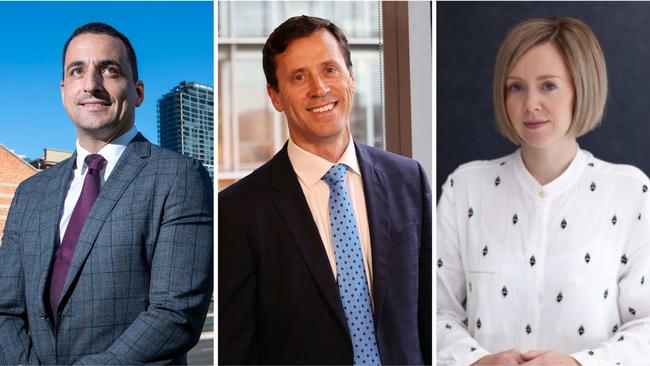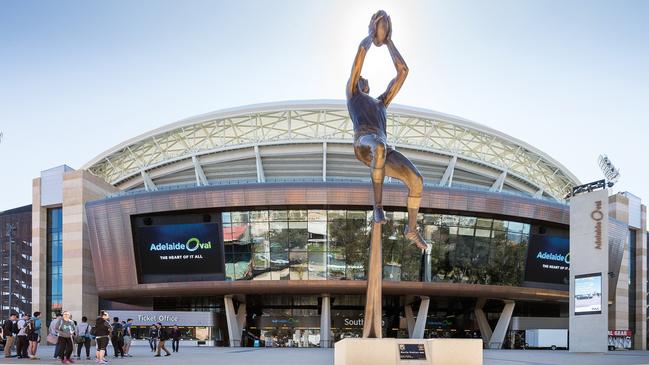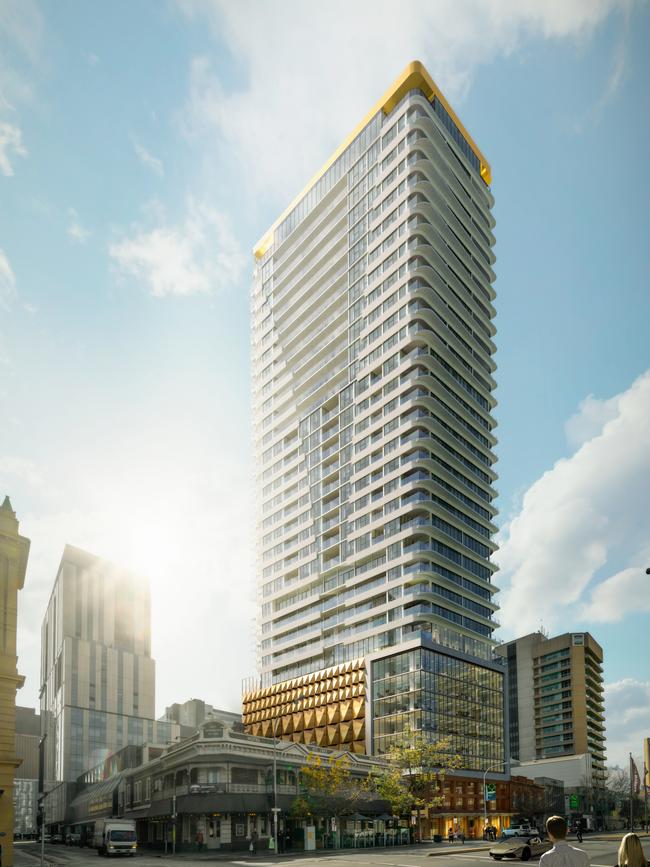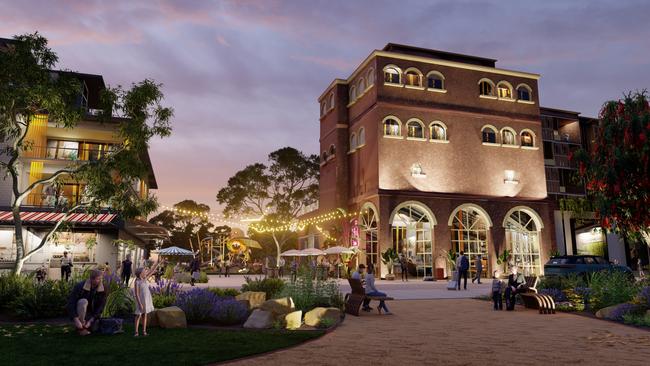Meet Adelaide’s 12 most influential city shapers and what they think the city will look like in 30 years
They are most influential developers, builders and architects behind the city’s changing skyline and these are their predictions for the future.

SA News
Don't miss out on the headlines from SA News. Followed categories will be added to My News.
What will Adelaide look like in 30 years’ time? It is the million dollar question and these are the million dollar people with the answers.
They are developers, builders and architects who have been most responsible for shaping the city’s urban landscape over the last two decades, making high-profile and striking additions to the Adelaide skyline.
These are The Advertiser’s top 12 city-shapers – read on to find out what they have built and where they think Adelaide is headed.
Jamie McClurg
Commercial & General co-founder and executive chairman

Jamie McClurg founded Commercial & General in 1999, the state’s largest commercial developer by dollar value of projects, and currently serves as its executive chairman.

Mr McClurg’s builds include the $500m Australian Bragg Centre for cancer research, and the forthcoming $250m 88 O’Connell St apartments – building on a site that had sat empty for more than 30 years.
“As a developer, it didn’t necessarily make financial sense to take on, but it makes sense from a community perspective,” he said.
“We want projects that achieve social and community value. It’s an investment in the state and I think it will give fresh life to North Adelaide.”

McClurg said he believes Adelaide’s CBD should instead be viewed as a “central living district” by government and planners, arguing the city is “about 200,000 people short of a perfect vibe” when it comes to cultural and economic vibrancy.
Chris Vounasis
Future Urban managing director

Chris Vounasis is managing director of Future Urban, which has handled planning approvals for several major infrastructure projects – but none as significant as Keystone Tower.
South Australia’s first skyscraper was given the green light in July, amid controversy over its height and how it would affect North Terrace’s heritage character.

“It’s tall, it’s different, but at the end of the day, when you view this project in the context of other cities, it’s quite normal,” Mr Vounasis said.
“But it shows confidence in our market and that the state can deliver these kinds of big infrastructure projects.”
Mr Vounasis said he believed over the next 30 years, Adelaide can expect taller buildings on the fringes of the CBD, giving it a flattened appearance rather than tapering down from the city centre.
He also said more student accommodation was being sought by SA universities, which in turn would free up small and medium-sized dwellings.
Adam Hannon & Zoe King
COX Architecture SA directors


COX Architecture’s streamlined and futuristic designs have become ubiquitous on the Adelaide skyline.
SA branch co-directors Adam Hannon and Zoe King worked on some their most high-profile designs, including the $526m Adelaide Oval redevelopment, Adelaide Botanic High School on Frome St and the Her Majesty’s Theatre revamp and extension.
Most recently, they oversaw the new 60 King William office complex on the former Southern Cross Arcade site, which was recognised at the 2024 SA Architecture Awards.


Mr Hannon said he believed new builds should complement Adelaide’s heritage buildings and green landscapes.
“If you look at the Oval, it is a project that celebrates the parklands and their natural beauty,” he said.
“It’s open to the surrounding environment and connects the sporting event experience to the outside in a way that is different to a traditional sports stadium.
“There are great cities like Adelaide where we must retain and celebrate its history, otherwise it’s gone before you know it.”
With current trends in population growth and tourism, Mr Hannon said he expected further development in the city centre, including more commerce, events and public buildings.
“I think the activation of the city centre, with the parklands around them, will be the magic ingredient,” he said.
Craig Weaver and Michael Gramazio
Synergy Construct directors

Adelaide has certainly become a much taller city over the past decade, and Synergy Construct has played a big part in making that happen.
Friends Craig Weaver and Michael Gramazio went into business together in 2013, specialising in the construction of city high rise buildings like the Switch and Yugo Adelaide student accommodation towers on North Terrace.
In fact, Mr Weaver said he had only built one new office building since then, and most of the demand in their sector was in apartments, hotels and purpose-built student housing.
Many of the developers he spoke to were drawn to SA because of a more “streamlined” building approvals process, compared to their experiences in the eastern states.


“Since we’ve started in business, we’ve built over 3000 student beds in Adelaide and we’re expecting to do deliver another thousand of these in the next 24 months or so,” Mr Weaver said.
“I think we’re just seeing the beginning, especially with the current university merger that is underway and the demand for student housing is continuing to grow.
“I think it’s going to be very good for the South Australian economy and I think the universities merging will have a positive impact in this space.”
Synergy’s other major builds in Adelaide include the two Y-Suites student accommodation buildings and the Vibe Hotel on Flinders St, while construction is underway on Victoria Tower on Grote Street, which will be Adelaide’s fourth-tallest building when finished.
Chris Menz
RenewalSA chief executive

Usually government is synonymous with red tape – but that’s where Chris Menz comes in to help.
RenewalSA was founded in 1995 to co-ordinate government-driven urban renewal projects, transforming a number of languishing commercial sites into mixed-use developments, including Lot Fourteen, the Tonsley Innovation District and Plant4Bowden.
Mr Menz took the wheel in 2019 and plans to add to that portfolio with more than 1000 new homes at the old West End Brewery site and a new 800-home master planned neighbourhood in Aldinga.

With the population of Greater Adelaide expected to soar from 1.5m to 2.2m by 2051, Mr Menz said “developing the services needed while maintaining liveability are all critical factors”.
“We need a continued focus on strategic density and infill in well serviced areas, along with more innovative financing and delivery models for home occupancy and ownership, which will help ensure more people can afford to live in, or own a home,” he said.
“The community is also telling us that, along with lifestyle, sustainably built housing and living costs will continue to be key issues which I think is driven from both social consciousness and cost-of-living pressure.”
“Building the critical skills needed to grow our city and economy, and a continued effort to embrace innovative building technology, and IT platforms and AI to reduce labour in a scarce skill market may help improve speed in delivery and affordability, which will be essential in building Adelaide’s future.”
David Gallant
Walker Corporation chief executive and managing director

Billionaire Lang Walker led the company bearing his name from its founding in 1964 until his death last year.
David Gallant was a natural successor, having worked at the company in various roles since 1997 and helping deliver the $600m Festival Plaza revamp and the adjoining Festival Tower.
His next challenge is finishing the $3b Riverlea master planned community on Adelaide’s northern fringes, aiming to deliver 12,000 homes over the next 20 years.

Mr Gallant said his mentor recognised “the enormous potential in Adelaide’s beautiful landscape, growing economy and hardworking people”.
“Over the next 30 years, Adelaide will further cement its position as a state with high quality jobs, great communities and excellent health and education facilities,” Mr Gallant said.
“It will continue its strong economic growth off the back of defence, health and education opportunities for all South Australians.”
Daniel Palumbo
Palumbo Group managing director

In the span of two decades, family-owned builder Palumbo Group went from delivering small Housing Trust dwellings to the futuristic Sofitel Tower on Currie St.
Under the stewardship of Daniel Palumbo, the $140m five-star hotel opened in 2021 after facing Covid-related logistic issues.
His company, co-operated with brothers Don and Anthony, also handled East Park Kent Town, a 98-apartment living complex overlooking the parklands at 1 King William St.


Mr Palumbo said he believed that the AUKUS submarine project and resulting influx of workers would create an additional demand for housing in and around the city.
Louis Kanellos
Chasecrown director

Known for its residential mid-rises and town house projects, Chasecrown scored a significant goal in June when the first sod was turned on its $120m Parkline apartments at Kent Town.

The 12-storey tower is the latest in a growing number of apartments cropping up around the city fringes, owing to PlanSA’s expedited approvals for areas with growth potential.
The company Louis Kanellos founded in 1992 is also responsible for the Eight South Esplanade apartment block at Glenelg and its distinctive oceanic-inspired surface.
Theo Samaras
Kyren Group founder and managing director

Until the Keystone Tower goes up, Theo Samaras is still responsible for Adelaide’s tallest building, along with a raft of other high-rise builds.
The 138m tall Frome Central Tower One hotel and apartment complex on Frome Rd went up in 2019, eclipsing former titleholder Westpac House by just three metres.

Mr Samaras is known for speculating on office developments, and in 2023, his group began construction on yet another one, a $100m, 17-storey office complex at 50 Franklin St, next to PwC’s headquarters.
Thomas Masullo
Woods Bagot director and global management leader
When Edwards John Woods and Walter Bagot partnered in 1905, they would have been surprised by what the company baring their name turned into.

The sandstone Bonython Hall on North Tce is a far cry from Woods Bagot’s contemporary work, including the SAHMRI building – nicknamed the ‘cheese grater’ – and the $350m expansion of the Adelaide Convention Centre.


Thomas Masullo was a lead architect on both of these projects, and also spearheaded the Department of Infrastructure and Transport’s recognisable offices at 83 Pirie St, which are completely carbon neutral.

Mr Masullo said he believed the city would continue to grow, but developers and planners were prizing “accessibility” and “sustainability” more than ever before.
“There’s a lot of investment into getting people into the CBD effectively through public transport, so there’s that efficiency in having a connected city that’s going to be really, really important,” he said.
“I don’t think the changes will be as much about the visuals, it’s becoming more and more about the things you can’t see – energy efficiency, sustainability, cultural overlay, liveability... All of that is what makes a really good city.”




